Despite its image as a high-tech country, a lot of Japan’s government paperwork still takes the form of bound collection of hard copies of legal documents. The National Diet Library has the responsibility of housing countless numbers of these collections.
However, like a fiery balrog, water is the bane of physical printed documents (which admittedly have a bit of a problem with fire, too). The National Diet Library occasionally has to deal with restoring books that have become wet before water damage sets in. Recently, the library revealed its simple, easy to copy technique for properly drying out a soggy book.
The library’s website lists spilled cups of water, ruptured pipes, leaky roofs, and malfunctioning sprinklers as probable causes of water damage, confirming our theory that the building does not, in fact, operate as a venue for raging after-hours keggers for Japanese politicians.
▼ A book, damaged by water or perhaps that blue liquid from diaper and tampon commercials
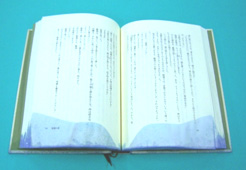
The procedure doesn’t call for any equipment you’re unlikely to have laying around you home or office, nor does it require any special training.
You’ll need:
– Cloth towel, preferably made of absorbent material
– Roll of paper towels or stack of printer paper
– Electric fan or hair dryer
– A few hard flat surfaces (cutting boards will do the trick)
– Paperweight or something similarly small and heavy
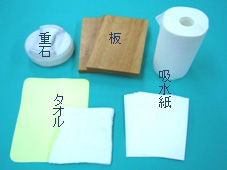
Start by pressing the towel onto the wettest parts of the page, to soak up as much of the liquid as initially possible.
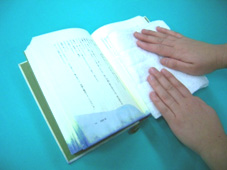
Next, place paper towels or printer paper between the pages of the book that are still wet, being carful not to jam so much in as to distort the shape of the book itself.
▼ Although, if the National Diet Library has talking books, as shown here, we really wonder why it matters if the pages are legible or not
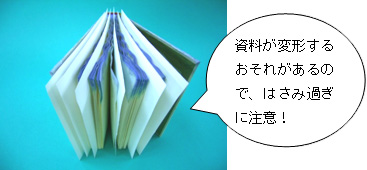
If the book’s cover is stiff enough to support its weight, stand the book on edge, with the wet portion at the top. If the cover is too soft for this, lay the book flat on the table. Turn on the fan or dryer and aim it at the book. Make sure the air flow is not so strong as to knock any standing books, and if using a dryer use only cold air, not hot.
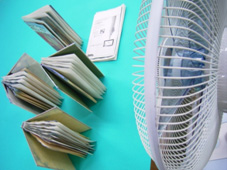
As they become damp, periodically replace the paper towels or printer paper inside the book as needed, until the moist portions of its pages no longer feel cold to the touch.
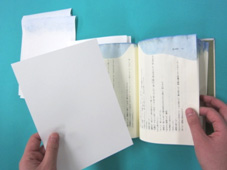
Once that happens, remove the drying papers, and place the book or books on a hard, flat surface to finish drying. Alternate layers of boards and books, with a single sheet of paper above and below each book to prevent sticking. To keep the books from warping, place the paperweight on top of the entire stack.
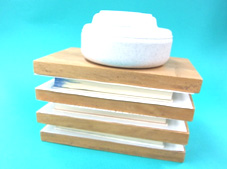
If complete drying takes more than a day, remove the books from the stack at least once every 24 hours and flip through the pages to make sure they’re not fusing together.
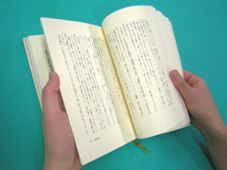
The library’s website goes on to list a few other points of advice. If, as a result of the moisture, mold has started to develop, the book should be isolated from other materials and the affected areas cleaned with an ethanol solution.
Photos tend to be printed on paper with a special coating, which is particularly prone to sticking to other similarly-coated surfaces. Should this occur, the pages can be separated using a spatula, although this also carries a risk of damaging the surfaces, and should be done with caution, if at all.
Finally, the National Diet Library, and we here at RocketNews24, take no responsibility for any problems that may occur with the above process, and stress that it is not to be used with materials that are delicate or have already reached an advanced stage of degradation.
In other words, this technique isn’t so much for your copy of the magna carta stained with fine port on as it is the 100 yen comic you spilled some canned beer on.
Sources: National Diet Library, Net Lab
Insert images: National Diet Library

 e.l.f. Cosmetics delights Frozen fans with an Elsa makeover in a book
e.l.f. Cosmetics delights Frozen fans with an Elsa makeover in a book These 19th-century Japanese miniature landscapes show that size isn’t everything
These 19th-century Japanese miniature landscapes show that size isn’t everything Police on the lookout for Arashi “fan” who stole articles about the group from public library
Police on the lookout for Arashi “fan” who stole articles about the group from public library First-of-its-kind towel is totally worth its 5,000 yen price, customers say
First-of-its-kind towel is totally worth its 5,000 yen price, customers say Frightening video shows how quickly Korean university’s library flooded in fierce storm 【Video】
Frightening video shows how quickly Korean university’s library flooded in fierce storm 【Video】 Red light district sushi restaurant in Tokyo shows us just how wrong we were about it
Red light district sushi restaurant in Tokyo shows us just how wrong we were about it Japanese ramen restaurants under pressure from new yen banknotes
Japanese ramen restaurants under pressure from new yen banknotes Pokémon Sleep camping suite and guestrooms coming to Tokyo Hyatt along with giant Snorlax burgers
Pokémon Sleep camping suite and guestrooms coming to Tokyo Hyatt along with giant Snorlax burgers Starbucks Japan adds a Motto Frappuccino to the menu for a limited time
Starbucks Japan adds a Motto Frappuccino to the menu for a limited time Tokyo Tsukiji fish market site to be redeveloped with 50,000-seat stadium, hotel, shopping center
Tokyo Tsukiji fish market site to be redeveloped with 50,000-seat stadium, hotel, shopping center Beautiful Red and Blue Star luxury trains set to be Japan’s new Hokkaido travel stars
Beautiful Red and Blue Star luxury trains set to be Japan’s new Hokkaido travel stars Akihabara pop-up shop sells goods made by Japanese prison inmates
Akihabara pop-up shop sells goods made by Japanese prison inmates Mt. Koya planning to instate visitor’s tax to cope with huge tourist numbers
Mt. Koya planning to instate visitor’s tax to cope with huge tourist numbers McDonald’s new Happy Meals offer up cute and practical Sanrio lifestyle goods
McDonald’s new Happy Meals offer up cute and practical Sanrio lifestyle goods Sakura tree falls on man at Sannenzaka near Kiyomizu temple in Kyoto 【Breaking News】
Sakura tree falls on man at Sannenzaka near Kiyomizu temple in Kyoto 【Breaking News】 All-you-can-drink Starbucks and amazing views part of Tokyo’s new 170 meter-high sky lounge
All-you-can-drink Starbucks and amazing views part of Tokyo’s new 170 meter-high sky lounge More foreign tourists than ever before in history visited Japan last month
More foreign tourists than ever before in history visited Japan last month French Fries Bread in Tokyo’s Shibuya becomes a hit on social media
French Fries Bread in Tokyo’s Shibuya becomes a hit on social media Studio Ghibli releases new action figures featuring Nausicaä of the Valley of the Wind characters
Studio Ghibli releases new action figures featuring Nausicaä of the Valley of the Wind characters New private rooms on Tokaido Shinkansen change the way we travel from Tokyo to Kyoto
New private rooms on Tokaido Shinkansen change the way we travel from Tokyo to Kyoto Starbucks reopens at Shibuya Scramble Crossing with new look and design concept
Starbucks reopens at Shibuya Scramble Crossing with new look and design concept Studio Ghibli glasses cases let anime characters keep an eye on your spectacles
Studio Ghibli glasses cases let anime characters keep an eye on your spectacles Beautiful Ghibli sealing wax kits let you create accessories and elegant letter decorations【Pics】
Beautiful Ghibli sealing wax kits let you create accessories and elegant letter decorations【Pics】 Studio Ghibli releases Kiki’s Delivery Service chocolate cake pouches in Japan
Studio Ghibli releases Kiki’s Delivery Service chocolate cake pouches in Japan New definition of “Japanese whiskey” goes into effect to prevent fakes from fooling overseas buyers
New definition of “Japanese whiskey” goes into effect to prevent fakes from fooling overseas buyers Our Japanese reporter visits Costco in the U.S., finds super American and very Japanese things
Our Japanese reporter visits Costco in the U.S., finds super American and very Japanese things Studio Ghibli unveils Mother’s Day gift set that captures the love in My Neighbour Totoro
Studio Ghibli unveils Mother’s Day gift set that captures the love in My Neighbour Totoro New Japanese KitKat flavour stars Sanrio characters, including Hello Kitty
New Japanese KitKat flavour stars Sanrio characters, including Hello Kitty New Pokémon cakes let you eat your way through Pikachu and all the Eevee evolutions
New Pokémon cakes let you eat your way through Pikachu and all the Eevee evolutions Disney princesses get official manga makeovers for Manga Princess Cafe opening in Tokyo
Disney princesses get official manga makeovers for Manga Princess Cafe opening in Tokyo Sales of Japan’s most convenient train ticket/shopping payment cards suspended indefinitely
Sales of Japan’s most convenient train ticket/shopping payment cards suspended indefinitely Sold-out Studio Ghibli desktop humidifiers are back so Totoro can help you through the dry season
Sold-out Studio Ghibli desktop humidifiers are back so Totoro can help you through the dry season Japanese government to make first change to romanization spelling rules since the 1950s
Japanese government to make first change to romanization spelling rules since the 1950s Ghibli founders Toshio Suzuki and Hayao Miyazaki contribute to Japanese whisky Totoro label design
Ghibli founders Toshio Suzuki and Hayao Miyazaki contribute to Japanese whisky Totoro label design Doraemon found buried at sea as scene from 1993 anime becomes real life【Photos】
Doraemon found buried at sea as scene from 1993 anime becomes real life【Photos】 Tokyo’s most famous Starbucks is closed
Tokyo’s most famous Starbucks is closed One Piece characters’ nationalities revealed, but fans have mixed opinions
One Piece characters’ nationalities revealed, but fans have mixed opinions We asked a Uniqlo employee what four things we should buy and their suggestions didn’t disappoint
We asked a Uniqlo employee what four things we should buy and their suggestions didn’t disappoint Princesses, fruits, and blacksmiths: Study reveals the 30 most unusual family names in Japan
Princesses, fruits, and blacksmiths: Study reveals the 30 most unusual family names in Japan Japan-made printer briefly impresses the Internet by catching its own paper
Japan-made printer briefly impresses the Internet by catching its own paper Clever trick fights soy sauce stains, is a godsend for people clumsy with chopsticks 【Video】
Clever trick fights soy sauce stains, is a godsend for people clumsy with chopsticks 【Video】 We try making dried flowers using a special, fast technique and get unexpectedly good results
We try making dried flowers using a special, fast technique and get unexpectedly good results Bookstore-styled Tokyo hostel has 1,700 books to read, bunks in the shelves to sleep next to them
Bookstore-styled Tokyo hostel has 1,700 books to read, bunks in the shelves to sleep next to them Crummy Japanese dish dryer still gets five-star reviews on Amazon for unexpected reason
Crummy Japanese dish dryer still gets five-star reviews on Amazon for unexpected reason Penguin Bomb papercraft is the most amazing thing you’ll see today【Video】
Penguin Bomb papercraft is the most amazing thing you’ll see today【Video】 University library in Tokyo may be world’s coolest with its “floating” meeting rooms【Pics】
University library in Tokyo may be world’s coolest with its “floating” meeting rooms【Pics】 New heated clothes hanger will dry your clothes in any type of weather
New heated clothes hanger will dry your clothes in any type of weather Samurai parkas for men feature traditional washi Japanese paper details
Samurai parkas for men feature traditional washi Japanese paper details Yoshinoya’s wagyu beef box for Japanese politicians
Yoshinoya’s wagyu beef box for Japanese politicians Nara unveils new vending machines that sell deer crackers
Nara unveils new vending machines that sell deer crackers Say sayonara to the hideous water stains on your wooden table with this easy trick!
Say sayonara to the hideous water stains on your wooden table with this easy trick! Otaku shopping spree: How would you spend $5,000 in Akihabara?
Otaku shopping spree: How would you spend $5,000 in Akihabara? Wow, literature is cute! Hiroshima library designs anime mascots for decimal classifications
Wow, literature is cute! Hiroshima library designs anime mascots for decimal classifications Drink like an ox, eat like a horse! Five Japanese idiomatic phrases to celebrate Year of the Ox
Drink like an ox, eat like a horse! Five Japanese idiomatic phrases to celebrate Year of the Ox Centuries-old book of ninja secrets discovered at public library in Japan’s Aomori Prefecture
Centuries-old book of ninja secrets discovered at public library in Japan’s Aomori Prefecture
Leave a Reply